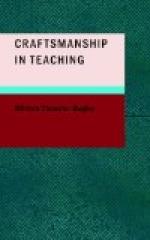This “reform movement,” as I shall call it, represents our first plunge into the wilderness. We would get away from the entanglements of drill and into the clearings of pleasurable, spontaneous activities. A new sun of hope dawned upon the educational world.
You are all familiar with some of the more spectacular results of this movement. You have heard of the schools that eliminated drill processes altogether, and depended upon clear initial development to fix the facts and formulae and reactions that every one needs. You have heard and perhaps seen some of the schools that were based entirely upon the doctrine of spontaneity, governing their work by the principle that the child should never do anything that he did not wish to do at the moment of doing,—although the advocates of this theory generally qualified their principle by insisting that the skillful teacher would have the child wish to do the right thing all the time.
Let me describe to you a school of this type that I once visited. I learned of it through a resident of the city in which it was located. He was delivering an address before an educational gathering on the problems of modern education. He told the audience that, in the schools of this enlightened city, the antiquated notions that were so pernicious had been entirely dispensed with. He said that pupils in these schools were no longer repressed; that all regimentation, line passing, static posture, and other barbaric practices had been abolished; that the pupils were free to work out their own destiny, to realize themselves, through all forms of constructive activity; that drills had been eliminated; that corporal punishment was never even mentioned, much less practiced; that all was harmony, and love, and freedom, and spontaneity.
I listened to this speaker with intense interest, and, as his picture unfolded, I became more and more convinced that this city had at last solved the problem. I took the earliest opportunity to visit its schools. When I reached the city I went to the superintendent’s office. I asked to be directed to the best school. “Our schools are all ‘best,’” the secretary told me with an intonation that denoted commendable pride, and which certainly made me feel extremely humble, for here even the laws of logic and of formal grammar had been transcended. I made bold to apologize, however, and amended my request to make it apparent that I wished to see the largest school. I was directed to take a certain car and, in due time, found myself at the school. I inferred that recess was in progress when I reached the building, and that the recess was being celebrated within doors. After some time spent in dodging about the corridors, I at last located the principal.
I introduced myself and asked if I could visit his school after recess was over. “We have no recesses here,” he replied (I could just catch his voice above the din of the corridors); “this is a relaxation period for some of the classes.” He led the way to the office, and I spent a few moments in getting the “lay of the land.” I asked him, first, whether he agreed with the doctrines that the system represented, and he told me that he believed in them implicitly. Did he follow them out consistently in the operation of his school? Yes, he followed them out to the letter.




